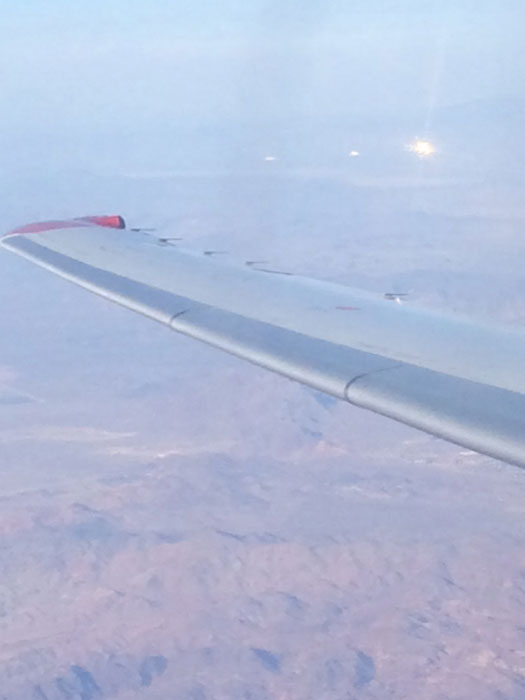Ivanpah Power Tower Catches Fire
May 19, 2016 - Misalignment of mirrors caused some to accidentally focus intense concentrated solar flux on the Unit 3 tower instead of the receiver. Damage was caused to steam pipes and the plant was shut down, reducing output of the solar project by a third. NRG told Bloomberg that no one was hurt and that the Unit is offline during damage assessment and development of a repair plan.
This is almost exactly what was predicted by expert witnesses in 2010 during the California Energy Commission (CEC) evidentiary hearings for ISEGS -- there was concern that if three mirrors accidentally misaligned together it could cause damage to something off the project site. CEC had an expert on this that was concerned a misalignment could aim toward drivers on Interstate 15 and cause damage to a person's eyes.
We speculate that perhaps the Ivanpah project is having problems with heliostats getting off kilter by the flooding that continues to happen through the solar field on the active alluvial fan they decided to build on, causing erosion around mirror poles. Plus mowing the desert there instead of grading might have allowed small burrowing animals like rodents to continue to live in the solar field, perhaps digging around heliostat bases. The poles were pounded/vibrated in, they do not have cement bases as far as we can tell. All this could cause small misalignments, throwing their precise heliostat geometric aiming off.
A good argument for smaller and distributed solar.
See the Las Vegas Sun: http://m.lasvegassun.com/news/2016/may/19/mirrors-blamed-for-fire-at-ivanpah-solar-plant-nea/
Office of Ratepayer Advocates Recommends Default for Ivanpah Plants
January 23, 2016 - The Office of Ratepayer Advocates (ORA), a part of the California Public Utilities Commission, protested Pacific Gas and Electric Company’s (PG&E) Advice Letter where PG&E sought CPUC approval of Forbearance Agreements between PG&E and Solar Partners II, LLC and Solar Partners VIII, LLC for Ivanpah Units 1 and 3. The Office or Ratepayer Advocates asked the CPUC to order PG&E to declare an Event of Default, saying it is in the best economic interests for ratepayers.
The actual costs to ratepayers from buying Ivanpah power is redacted in the ORA letter, but it is said to be excessively expensive, especially since photovoltaic solar prices have dropped hugely in recent years. Concentrated solar power plants have remained expensive to operate, and ISEGS especially so.
ORA also states that PG&E does not need Ivanpah to reach its Renewable Portfolio Standard goals, and recommends that the Energy Division of the CPUC allow the project to go into default. PG&E argues that they have an forbearance agreement that continues an uninterrupted stream of revenue, even if it is high-cost.
But ORA states, "declaring an Event of Default is the best, if not most, economic decision, based on the Commission’s principles of contract management and least cost dispatch."
ORA continues, saying "PG&E states the Solar Partner’s failure to meet its GEP [Guaranteed Energy Production] was a result of outages and reduced generation caused by the Solar Partners’ overestimation of generation forecast in their model, in addition to operation and management problems related to boiler issues, turbine vibrations, gas valve issues, steam tube leaks, unusually high cloud coverage." Basin & Range Watch during 2009-2010 evidentiary hearings with the California Energy Commission presented evidence about higher cloud cover in the eastern Mojave Desert due to summer monsoon activity which we believed was not taken into account. Further cloudy El Nino conditions have likely exacerbated generation problems due to winter cloudy days.
"While contracted prices may have reflected market value in 2009," ORA says, "it is
reasonable, due to the questionable operation and potential mismanagement of the projects, for the Commission to reevaluate the pricing terms and conditions adopted in the original agreements when considering adoption of PG&E’s advice letter request. It is also reasonable for the Commission, under these circumstances, to consider whether the past two years is sufficient time to evaluate project performance, and at what point it is in the ratepayers’ best interest for PG&E to declare a default."
"The Commission may have supported an innovative and promising technology when approving the initial PPAs, but the projects’ failure to delivery indicates that the technology is not successful in this instance."
If a default happens and operation ceases one possibility is that the federal government might take it over like they did the old Daggett solar power towe near Barstow CA, and keep it going as an "experimental solar plant."
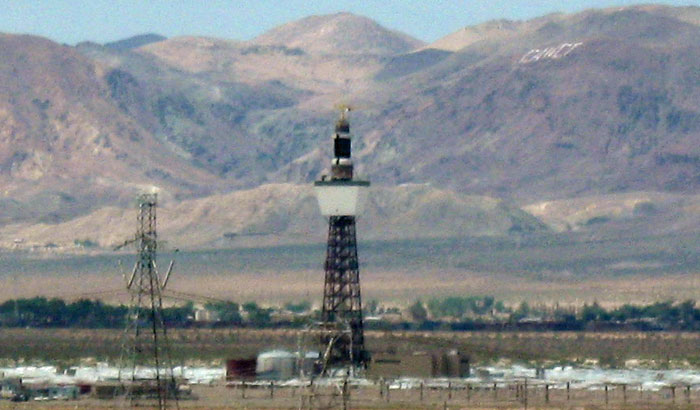
^Former Daggett solar power tower ceased operation, and later dismantled. Daggett, CA.
Ironic how utilities are arguing over a few cents in Net Energy Metering cases of possible cost shifts to non-solar customers by residential rooftop solar customers, but PG&E is willing to shift this "excessively high" (to quote ORA) cost of Ivanpah onto all their ratepayers.
Ivanpah Towers Face Default with PG&E Contract
December 23, 2015 - Two of the units of the Ivanpah Solar Electric Generating System are underperforming and not meeting their PG&E Power Purchase Agreement. The other unit has a PPA with Southern California Edison. PG&E subsequently gave the owners six more months to try to meet minimum requirements for power generation.
B&RW during 2009-2010 California Energy Commission evidentiary hearings pointed out there was higher average cloud cover from summer monsoons in the east Mojave compared to west Mojave, and many intervenors showed how the shadow reaching across the landscape from adjacent Clark Mountain (7,933 ft in elevation) would shade the project earlier in the day. The project was approved anyway.
http://ww2.kqed.org/news/2015/12/15/nrg-ivanpah-faces-chance-of-default-PGE-contract
http://ww2.kqed.org/news/2015/12/22/pge-wants-to-give-ivanpah-plant-more-time-to-meet-power-targets
Ivanpah Solar Flux and Bird Mortality
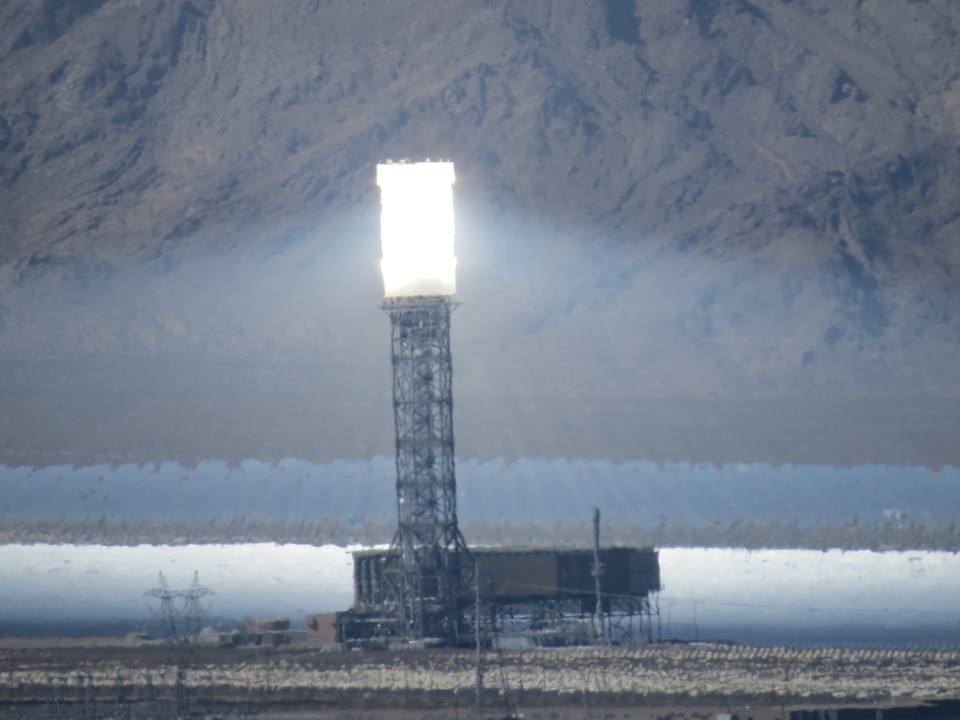
^Ivanpah Solar Electric Generating System - tower two - solar flux, September, 2015. The faint halo of white may be due to light energy intercepting dust in the air or water vapor, and could be contribuiting to the lower prefromance of the project.
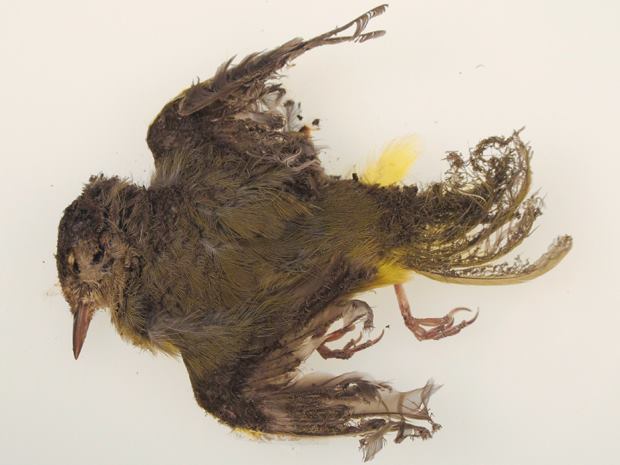
^Singed warbler at Ivanpah solar project (from US Fish and Wildlife Service).
September 7, 2015 - San Bernardino County CA - Migration is happening now, with a diversity of warblers, vireos, flycatchers, swallows, and other birds heading south through the Mojave Desert. Many can be seen resting and feeding at oases, springs, and wooded groves across the desert but also during the day these birds fly across vast open deserts and we have seen them flit through creosote in Ivanpah Valley looking for insects. Unlucky birds may unknowingly fly into the solar flux of concentrated solar thermal power towers and become burned.
When 300,000 mirrors focus the sun on one water filled receiver tower a “solar flux” is created. The ghostly white cone pictured here around Ivanpah Tower 2 is a concentration of heat with temperature ranging from 800 to over 1,000 degrees (and higher right next to the receiver) for a 2,000 foot radius around the tower. When the mirrors are moved to a stand by position, the flux can expand. The US Fish and Wildlife Service has called this a “Mega –Trap” for insects and birds. Birds have been observed vaporizing in the flux and have received the nickname “streamers”. The company biological contractors estimate that about 3,500 birds are killed per year by this project. Some do not burn, but collide with the mirrors. But many have dead birds have been found with singing on their bodies. The surveys cover just over 20 percent of the project for just a few days each month. Could this be an undercount? One biologist estimated 28,000 could be killed per year.
Bird Deaths Report

August 24, 2015 - Ivanpah Valley CA - The latest bird kill report for the Ivanpah Solar Electric Generating System includes 25 roadrunners (Geococcyx californianus) and a host of other species. Burning or singing from the solar tower flux was only detected on one roadrunner. The rest of the kills are listed as “unknown”. Other species include Green wing teal, American kestrel, Hermit Thrush, Yellow rumped warbler and Lazuli Bunting to name a few.
All bird and bat fatalities and injuries are being referred to as “detections”.
Avian and bat monitoring surveys were conducted from 21 October, 2014 to 15 March 2015. A total of 3 bat fatalities, and 340 avian detections (including 4 injured birds), were found.
Of the 340 dead birds found, 39 showed sign of collision and 86 showed sign of singing.
The question of course is, how representative of avian mortality
are these numbers?
Are they finding most of the birds and bats that are killed? And what about insects? Some birds could be attracted to insects that are attracted to the artificial light. There has been debate about weather insects would follow the artificial light in the day-time. And some birds have been observed “vaporizing” in the heat of the solar flux leaving no evidence.
And only a small percentage of the project is being surveyed. Approximately 29.2% of the facility was searched (not including the offsite transects, which are outside the facility). Searches were conducted within the winter season at intervals of approximately 21 days. Many of the carcasses were found two weeks after being killed. How many more are removed by scavengers?
The Ivanpah Solar Electric Generating System; Avian & Bat Monitoring Plan: 2014-2015 Winter can be viewed here:

^Roadrunner.
Problems With Large-scale Solar Thermal Projects Operating
June 16, 2015 - A recent Wall Street Journal article highlighted issues some of the large-scale concentrating solar thermal projects are having. The Ivanpah Solar Electric Generating System in San Bernardino County CA is only producing 40% of the power it was supposed to, mainly due to cloud cover and technical difficulties with the long steam pipe system. Basin & Range Watch had written comments during the early review of the project to the California Energy Commission back in 2009 and 2010 on how it was known at the time that the eastern Mojave desert areas had a stronger monsoonal flow in summer with more cloudy days, than the clearer West Mojave where older CSP plants have been operating since the 1980s.
Abengoa's Solana project in Arizona, a parabolic trough CSP plant, is underperforming by around 50%.
The photovoltaic California Valley Solar Farm in Kern County CA on Carrizo Plain is producing more electricity than rated for, although we wonder if this is due to being closer to the coast. Problems with flash flooding, dust, and intense heat might be hampering desert photovoltaic projects.
Ivanpah Valley: Three Solar Projects
May 22, 2015 - San Bernardino County CA and Clark County NV - Our photos this month showing how largescale solar energy projects fragment Mojave Desert ecosystems: Ivanpah Solar Electric Generating System, Stateline Solar Farm, and Silver State South Solar Farm, >>here.
Avian and Bat Mortality Report
April 20, 2015 - The compliance report, Ivanpah Solar Electric Generating System Avian & Bat Monitoring Plan - 2013-2014 Annual Report (Revised), was released by the California Energy Commission.
There were 703 avian detections represented by 83 different species during the first four seasons of monitoring. Based on the monitoring results, overall fatality estimates for this period were 1,492 (90% confidence intervals 1,046-2,371) from known causes (i.e., singeing, collisions, or entrapment within Project facilities) and 2,012 (90% confidence intervals 1,450-3,334) from unknown causes.
Although scavenger removal trials were done, carcasses placed in the project area with cameras pointed at them to detect removal by ravens, coyotes, and other scavengers, and human searcher trials were undertaken, we feel that more study needs to be done over a three-year period to obtain more estimates. Human searchers found approximately 50% of small bird carcasses placed in the project ground. In other studies such as by Shawn Smallwood at wind projects, searchers have missed many more small bird carcasses. So this number can be quite variable, but it is key to how total mortality estimates are made. More study is needed.
The report tries to make anargument that the bird deaths at the Ivanpah solar power towers are insignificant in the nationwide perspective of bird abundance. From pages 58-62: "Of the 19 species with 10 or more detections, two are special-status species (yellow warbler and Vaux’s swift, both state species of special concern) and thus are discussed in Section 3.6.1.2 below. None of the 17 other species represented by 10 or more detections is particularly rare locally, regionally, or nationally. Fifteen of these species, including the mourning dove (Zenaida macroura), yellow-rumped warbler, tree swallow (Tachycineta bicolor), black-throated sparrow, white-crowned sparrow (Zonotrichia leucophrys), horned lark, Costa’s hummingbird (Calypte costae), house finch, Anna’s hummingbird (Calypte anna), barn swallow (Hirundo rustica), American kestrel, rufous hummingbird (Selasphorus rufus), brown-headed cowbird (Molothrus ater), cliff swallow (Petrochelidon pyrrhonota), and lazuli bunting (Passerina amoena) are common to abundant species, and are fairly to extremely widespread species. Two others, the lesser nighthawk and greater roadrunner, have more limitedbreeding distributions but are still numerous within their breeding ranges and occur in large numbers in southeastern California.
"Even considering the site-wide fatality estimates for individual species listed in Table 25, the number of individuals of any given species that were recorded as detections, or that were estimated to have died, during the first four seasons of monitoring represents a minimal proportion of local, regional, or national populations. For example, the fatality estimates for the species recorded most frequently as a detection, the mourning dove, produced estimates of 118 (90% confidence intervals 63 – 194) from known causes in the
heliostat segments (the only Project component with sufficient detections of known cause to produce an estimate) and 294 (90% confidence intervals 184 – 458) from unknown causes in the heliostat segments and inner HD areas (the only Project component with sufficient detections of unknown cause to produce an estimate). Given the species’ North American population of approximately 349 million and annual take by hunters of nearly 14.5 million (Seamans et al. 2013), the loss of mourning doves at Ivanpah represents a very
small proportion of the population. Considering the much lower fatality estimates for the other species in Table 25, the magnitude of the fatality of these species at Ivanpah for the first four seasons of monitoring does not rise above the “low” category. Furthermore, the cause of death for 42.2% of the detections of species listed in Table 25 was unknown and thus cannot be determined.
"Of the 703 avian detections reported, 47 of the detections were of special-status species (Table 26). Five were bank swallows, which are State-listed as threatened. The remainder consisted of California species of special concern, which included 19 yellow warblers, 11 Vaux’s swifts, six loggerhead shrikes, three olive-sided flycatchers, and single Lucy’s warbler, yellow-breasted chat, and yellow-headed blackbird. Loggerhead shrikes breed in the vicinity of the site, but all the other special-status species recorded as detections are transients
that breed elsewhere.
"Singeing was evident on all five bank swallows, all 11 Vaux’s swifts, 14 of the yellow warblers, one of the olive-sided flycatcher, and the single Lucy’s warbler. One loggerhead shrike and one yellow warbler showed evidence of collision with a heliostat. The cause of death of the remaining special-status birds (five loggerhead shrikes, four yellow warblers, two olive-sided flycatchers, one yellow-breasted chat, and one yellow-headed blackbird) was unknown."
Some of these species such as Yellow-breasted chat, are increasingly rare in much of California due to habitat removal. Yellow warblers similarly have lost huge amounts of breeding habitat in the state and are subject to cowbird parasitism which holds their numbers down from historic abundance. But even more than simple numbers, this bird mortality report represents a swath of missing biodiversity of a particular Mojave Desert basin and surrounding mountain ranges. This large-scale solar project will be a sink for 30 years causing deaths in the region and impacting populations of birds in this ecosystem in unknown ways. Insect polinator mortality is yet another impoact that is unstudied. The area was previously a highly diverse desert ecosystem and is now impacted by a large source of mortality. The effects may ripple through the ecosystem. Will tortoises around the project be increasingly predated by ravens and scavengers that subsidized by so many bird carcasses?
Judges Hear Arguments in Two Cases Against Solar Project
April 10, 2015 - Pasadena CA - A three judge panel of the 9th Circuit heard from both sides in two cases challenging the Ivanpah Solar Electric Generating System in San Bernardino County CA -- Western Watersheds Project objected to its lack of proper environmental review, and Native American groups objected to restriction of religious freedom.
In the first case, Oakland-based Stephan Volker represented the environmental group Western Watersheds Project. He argued before the judges that the government failed to carefully analyze the project's impact on the area's desert tortoise population in violation of the National Environmental Policy Act's "hard look" standard.
The government's environmental impact statement, Volker said, failed to account for all of the juvenile tortoises and unhatched tortoise eggs in the area, leading the government to underestimate the population by a factor of more than 20.
Circuit Judge Andrew Kleinfeld said that counting the juveniles and the eggs would not have been a worthwhile effort, since most desert tortoise eggs do not hatch and more than 95 percent of juveniles do not survive to sexual maturity.
"That's like going to the grocery store and counting chickens by counting eggs," he said.
The judge also asked why this particular and relatively small piece of land is crucial to the survival of the species, especially given the plentiful desert habitat surrounding the solar plant.
"You've got a tiny dot of the vast area these tortoises live in," he said.
Basin & Range Watch disagrees with this subjective opinion of the judge, who has not been trained as a desert tortoise biologist and does not apparently understand the significance of a large breeding population in Ivanpah Valley and how it is surveyed. We will also point out that US Fish and Wildlife Service wrote a comment letter recommending that Ivanpah Valley be conserved for tortoises and not developed with largfe-scale renewable energy projects since it is an impoprtant genetic linkage corrirod bewteen desert tortoise populations. The science was ignored in the judges' statements.
The second case against the massive solar project came from the Native American group La Cuna De Aztlan, which says that the project blocks access to its sacred sites.
The group's attorney Cory Briggs argued before the panel that a fence surrounding the solar plant obstructs the Salt Song Trail and its numerous landmarks of religious significance to the group - the visitation of which is a "rite of passage."
Briggs said that the group's members often undertake sacred runs - which traverse multiple states and last weeks if not months - structured around the landmarks.
The judges questions and statements were bordering on insulting in our opinion, and showed a lack of respect for other cultures.
"So is what you're saying is that you want them to open the gate when an Indian comes and they can run right through it?" Judge Kleinfeld asked.
Judge Richard Clifton raised the issue of the landmarks' relative significance: "There's one temple location in Mecca that's of great significance," he said. "We have nothing telling us that there is such significance here."
Briggs answered that he was "somewhat uncomfortable not with the questions but with the flavor of them," since "the Supreme Court has urged that we be careful about not probing too difficultly into the sincerity of religious beliefs."
See more:
http://www.courthousenews.com/2015/04/10/enviros-indians-join-in-fight-against-solar-plant.htm
4/12/15
FOR IMMEDIATE RELEASE
Robert Lundahl & Associates
Robert Lundahl
415.205.3481
robert@studio-rla.com
La Cuna de Aztlán Sacred Sites Protection Circle
Patricia Robles Chairperson
lacunadeaztlan@aol.com
(760) 922-6422
LA CUNA DE AZTLÁN SACRED SITES PROTECTION CIRCLE ARGUES RELIGIOUS FREEDOM FOR NATIVE AMERICANS IN 9TH CIRCUIT COURT OF APPEALS
Judges Grill Attorneys From Both Sides Over Landmark Case
By Robert Lundahl
In December 2010, La Cuna de Aztlán Sacred Sites Protection Circle and CARE, Californians for Renewable Energy, along with 6 (six) Native American elders, filed suit against the Department of the Interior, Bureau of Land Management, and the Department of Energy, which were later joined by defendant project applicants for 6 of the first 10 industrial solar projects slated for the California deserts. The case, heard in the 9th Circuit, Friday April 10, in Pasadena, California, pertained specifically to the Ivanpah project, already constructed, and its applicant company, BrightSource.
BrightSource is an Israeli firm, which positioned itself to receive loan guarantees and cash grants under the ARRA stimulus program, American Recovery and Reinvestment Act of 2009. The primary objective for ARRA was to save and create jobs for Americans. Other non-American firms, like Solar Millennium AG, from Germany, also applied for and were granted permits to build utility scale renewable energy projects on public lands in the West. Solar Millennium AG is now bankrupt. Under the ARRA program, federal loan guarantees and cash grants were offered to companies. Cash grants totaled 30% of a project's budget. The Ivanpah project was budgeted at 2.2 billion USD.
Questions related to religious freedom came about because BrightSource's Ivanpah project was built on sections of the Salt Song Trail, sacred to Indian tribes and groups, including the Chemehuevi and Southern Paiute. The case was argued under RFRA, the Religious Freedom Restoration Act of 1993. The law mandates that strict scrutiny be used when determining whether the Free Exercise Clause of the First Amendment to the United States Constitution, guaranteeing religious freedom, has been violated.
The First Amendment of the Constitution of the United States states that "Congress shall make no law respecting an establishment of religion, or prohibiting the free exercise thereof”. The first part, known as the Establishment Clause, comes into play whenever the government takes an action that leads to suspicions that it is endorsing any or all religions. There is a second Free Exercise clause, which basically ensures that people should be free to practice their religion as they see fit.
La Cuna had challenged the projects on the basis they violated NEPA, the National Environmental Protection Act, The National Historic Places Act of 1966, AIRFA, the American Indian Religious Freedom Act, and several other laws protecting Native American antiquities and heritage, practices and culture, but the argument came down to RFRA on appeal.
Native American spiritual and cultural practices are often land-based, involving spiritual practices on the land. Land is a commodity in the American economic system, something which can be bought and sold. The fundamental conflict of values could result and has resulted in the destruction and loss of cultural identity, according to Chemehuevi Elder Phil Smith, and Quechan/Kumeyaay elder Preston Arrow-weed, in the film, "Who Are My People?" by filmmaker Robert Lundahl, http://whoaremypeople.com, which explores the grounds for and context of the legal case. Mr. Smith is a named litigant.
Laws specific to American Indians protect vulnerable cultural resources, which pre-existed the formation of modern nations, and represent the documentation of the identity and practices of those early cultures. But RFRA protects all Americans equally, and as such, may be the stronger argument by example.
La Cuna attorney Cory Briggs presented his argument first. He indicated his clients were trying to exercise their religious beliefs, and that the sincerity of those beliefs were not challenged. Those beliefs include utilization of the Salt Song Trail, a network of trails extending over a vast, four state area, from California to Northern Utah, through Nevada and Arizona. Part pilgrimage, part "rite of passage," the Salt Song Trail provides linkages between village locations and gathering sites for salt and medicinal herbs.
The usage of the Trail and its importance to tribes like the Chemehuevi and Southern Paiute does not translate easily. Judges questioned the importance of a "small location in a vast area" (The Ivanpah Site) to the exercise of those beliefs. "If you can use them and pray on them on all the rest of it, does it matter to the free exercise of religion? Does it significantly burden the exercise?" Briggs responded that according to litigants Smith and Ron Van Fleet, that going to the particular site was "meaningful to the practice of their religion." Justices wanted to know in specific what it is that is sacred, "Can you lose any part of the Salt Song Trail, even if there is no sites on it, just the fact that its part of the trail…? …(does that) burden your ability to follow this religious tradition?" Briggs responded, "Yes."
"Part of my clients' religious tradition is an oral history tradition…" Imagine a path... and along that path you have some significant markers. And for Native Americans on this path, on the Ivanpah site, there are significant religious markers that are part of the oral tradition and the handing down of their religion, that they have to actually be at… They have to have a certain view of the Clark Mountains, they have to be in a location, where the sun rises at a certain time… The problem is by putting a fence around the entire site, my clients can't get to the particular landmarks along the way."
Justices asked, "Suppose you win, does RFRA protect the entire four state area from any development?" Briggs responded,"The Ivanpah project is only dealing with a portion of this… we're not arguing you have to set aside the entire four states. What we are saying is that within the project, because it is now off limits, they built a fence around it, my clients can't get to the portions that are significant for their religion…"
"They used to do these runs. These runs would last weeks if not months. And literally might spend all day running, literally running, from one state to another. By putting up the fence, you are essentially requiring them to take a detour from "Point A" to "Point C," except "Point B" is religiously significant."
Briggs said again, related to the scope of the argument, in response to judges reference to the "compelling interest" of the government to "develop something" in the four state area, that the government must provide access to what is at least one significant marker existing on the Salt Song Trail, on the Ivanpah Project, and in subsequent phases must consult with the litigants so that no more destruction occurs. "The claim is not that you cannot touch any part of the Salt Song Trail, the claim is that there is at least one significant marker within the fenced off portion of the Ivanpah project. We're not arguing that you can't have your Ivanpah project." What we are arguing is that not being able to visit that site, freely…"
Justices: "Are you saying that all you want is for them to open the gate when an Indian comes and let them run through it and then you can have the Ivanpah project?" "That's a good chunk of it," responded Briggs, "Let me explain the other part, "if there are other phases that would require the destruction of a specific marker, that the government would need to work with my client to accommodate that."
Justices: "Your clients never brought this up, is the problem."
Briggs: "Actually we sued over the lack of consultations. We didn't raise this issue on appeal." According to Briggs, litigant Phillip Smith went to a meeting and indicated he wanted to be consulted on this project. BLM did not respond. "BLM took my information but never consulted with me," Smith is quoted as saying in the proceedings.
Justices: "I thought that was the way the government consulted."
Briggs: "This isn't some kid from Santa Monica in board shorts and a skateboard showing up and saying, "Hey I have an issue, this is a regular person consulted by the BLM on these issues, he goes to a meeting. He goes to a meeting and says, 'We need to have a chat about this project.' They do not follow up. There is a footnote in the federal government brief, saying, 'Look if you'd just contacted us we would have come to some agreement.' First of all, it's in a footnote, second, there's nothing in the record to suggest that that's true. And third, it is the government's obligation to at least engage in a back and forth with my clients."
"What interferes within their religion is going to the site to finish a portion of the run and being told, if you cross over the fence, you're going to be arrested."
Opposing counsel Robert Oakley from the Department of the Interior indicated that case law swung the other way. Justices asked, “Can you say that, in the context of what we have to take as the legitimate basis of their religious faith, can we take one part of that trail, wherever it may be, and know that it’s not going to be there any more and say we haven’t substantially burdened?
Oakley: I think you’d have to know for sure that it was a trail. I could refer to a case Judge Kleinfeld decided, the Huna case. It was not a RFRA case, it was National Historic Preservation Act, where the question was, “Had the government preserved some trails that were used in conflicts between Native Americans and Russians in Alaska, and the Court pointed out that these were very poorly marked, and that knowing something important happened in the area was not enough to make the entire area sacred.”
Justices: “You're the side that wanted access to the sacred trail, did you ever give them a map?”
Briggs: “The answer is yes, It's already in BLM's possession. It has been in BLM's possession for a long time. Let me be exactly precise, your honor. Did my clients in conjunction with this lawsuit, hand them the map? No…. The BLM actually has the inventory… They've had it for years. They have their own archaeologists and historians who know all of this stuff. To say that in this lawsuit my clients and I diid not hand them the map, is to feign ignorance on subject matter that the agencies and the tribes have long shared a common understanding over.”
In response to Mr. Oakley’s comments that BrightSource does not have authority to make arrests, and stating that there are gaps in the fence for transmission lines, which could be utilized for access, Briggs concluded (to the justices), "I realize you still have the difficult task of figuring out if it is in an area that is still fenced off is that still a significant burden. The only thing I would say to you is, just because the Sheriff is not there to watch somebody hop the fence… in other words, because you managed to not get caught… it's the threat of prosecution that is the burden, not the fact that the Sheriff gets there in time to see you scaling the fence.”
A complete audio recording is available from the 9th Circuit Court of Appeals http://cdn.ca9.uscourts.gov/datastore/media/2015/04/10/13-56799.mp3. A ruling on the hearing of oral arguments may take several months.
Fire and Problems During Testing
July 13, 2013 -- Steam pipe ruptures and a small fire occurred during testing of solar power towers in Ivanpah Valley in May.
See ReWire at KCET - http://www.kcet.org/news/rewire/solar/concentrating-solar/pipeline-rupture-fires-vex-ivanpah-solar-crews.html
Video of "Streamers" in Solar Fluyx
Febriary 25, 2015 - Probably the most clear video of the "streamers" burning up in the solar flux at the Ivanpah Solar Project. "Streamers" are the unlucky birds and insects that fly into the hot, lethal solar flux produced by hundreds of thousands of heliostat mirrors concentrated on a receiver tower. This video is from one day in November but it happens every day and is believed to kill tens of thousands of birds a year. The project runs on about 30 percent of its projected capacity.
VIMEO.COM|BY NORMANROGERS
Forbes Article on Ivanpah Solar Power Towers
November 12, 2014 - Basin & Range Watch does not support nuclear power because of the toxic waste associated with these plants, but Forbes has a good article describing in detail how the Ivanpah Solar Electric Generating System has not lived up to the cost, and rooftop photovoltaic solar would be a better option.
Thermal Solar Energy -- Some Technologies Really Are Dumb
The largest solar energy facility in the world is already irrelevant and has cost a lot more to construct than any other form of energy. The Ivanpah Solar Electric Generating System is a 5-square-mile, 392 MW array that cost $2.2 billion. It is located in the Mojave Desert, where the Sun always shines, and is supposed to produce a billion kWhs per year for 25 years.
Cloud Shadows
October 23, 2014 - Ivanpah Valley, CA - A visit to the desert valley south of Las Vegas, NV, showed all three power towers on. Yet some late cumulus clouds formed in the afternoon and slowly moved towards the vast solar fields. Before each cloud shadow reached the mirrors that reflect sunlight intensely onto the tower, each unit was turned off. Heliostats with garage-door sized mirrors were turned to face upward instead of directed onto the receiver on top of the tower, shutting down the white-hot glow. When this happens the water in the tower pipes ceases to superheat into steam, and does not contribute to turning the steam turbine to produce electricity. At one point all three towers were "off."
The operator must do this in order to not damage the receiver: if one side was absorbing intense solar flux from sunlight-reflecting mirrors, and another side of the receiver was cool from shadowed mirrors, the receiver could warp. So the operator shuts the plant down before the cloud shadows move over.
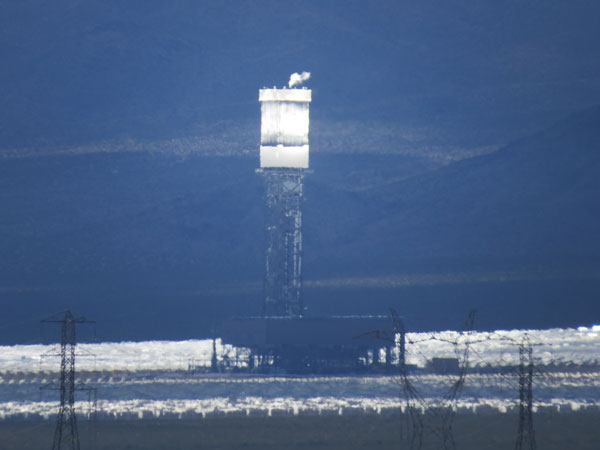
^ON: White-hot glow of sunlight reflected by mirrors.
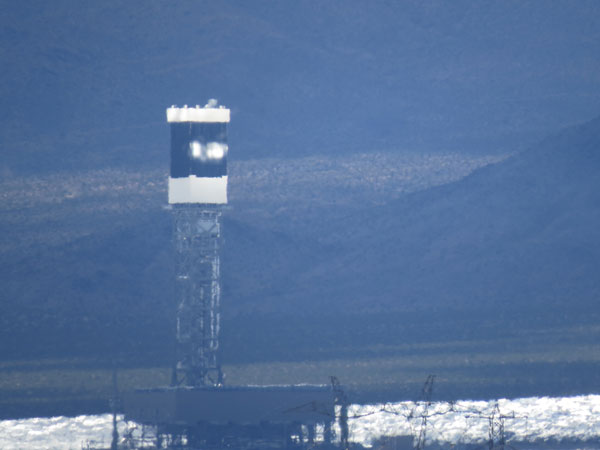
^OFF: the tower receiver is darkened as most mirrors are aimed away due to cloud shadows over the solar field.
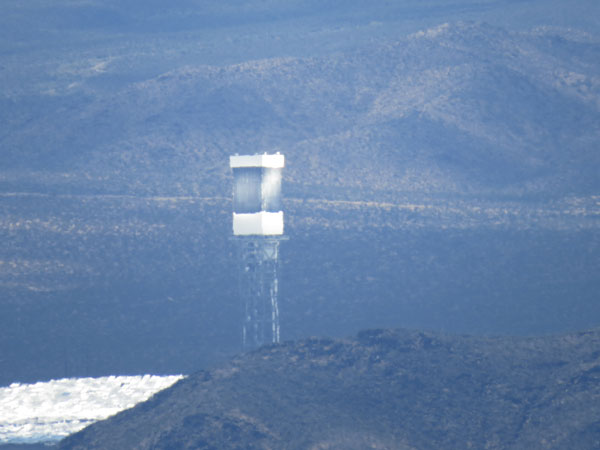
^OFF: a view from across the valley of Unit 2 off.
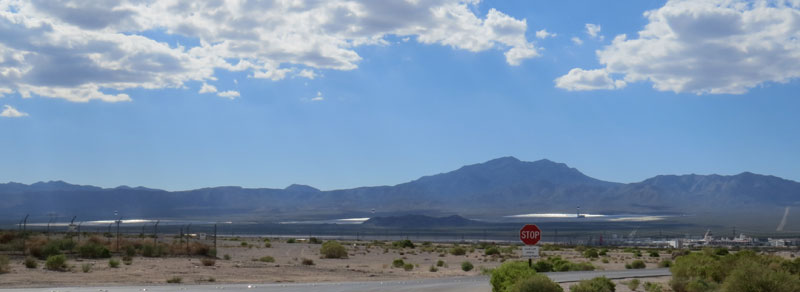
^Clouds move over the solar fields in Ivanpah Valley, all three units turned off.
Birds Igniting in Midair: CBS News Reports on Ivanpah and Palen Solar Power Towers
August 18, 2014 - CBS News headlines the controversy over bird deaths at the Ivanpah Solar Electric Generating System raised by biologists:
http://www.cbsnews.com/news/calif-solar-power-plants-scorching-birds-in-midair/
Ivanpah Power Towers Allowed to Burn More Natural Gas
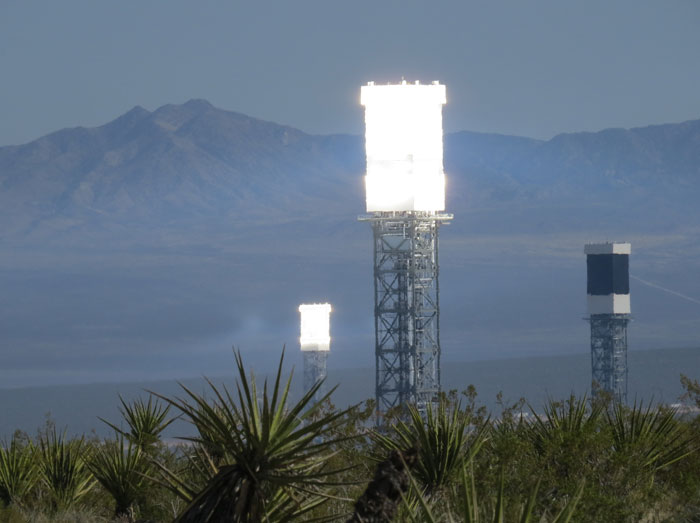
June 28, 2014 - The California Energy Commission approved a request to raise the limit on the amount of natural gas burned in boilers at the Ivanpah solar project which requires steam heated by the sun and auxilliary boilers to power steam turbines to generate electricity. The notice states:
“Solar Partners have stated in their petition that the auxiliary boilers will need to operate an average of approximately 5 hours a day during daily startup (instead of the original expectation of an average of approximately 1 hour per day) in order to ensure that steam flow is sufficient to carry excess heat from the receivers in the towers and to
ensure that equipment components continue to operate as designed. Based on ISEGS
experience since December, 2013, Solar Partners became aware of a need for
additional fuel use in the auxiliary boiler during periods of intermittent cloud cover, after
the turbine tripped off-line during extensive cloud cover, and at the end of the day to
extend solar power production.”
In addition the CEC notice explains:
"Operating experience since commencement of commercial operation in December
2013, has shown that more steam is needed from the auxiliary boilers than originally
expected to optimize operations and maximize solar output.
"Auxiliary boilers typically need to operate an average of approximately 5 hours a
day during startup (an increase from the 1-hour daily average originally
expected) to ensure that steam flow is sufficient to carry excess heat from the
receivers in the towers and that when weather conditions are sufficient to permit
plant operation, plant equipment and systems are ready to operate as designed.
"Additional fuel is needed during some days to compensate for intermittent cloud
cover to maintain peak power production and prevent the steam turbine from
tripping off-line. When cloud cover is dense enough and/or persists long enough
to trip the turbine off-line, steam generated by the auxiliary boilers is needed to
restart solar power production.
"Auxiliary boiler operation is needed at the end of the day to stabilize or support
steam turbine operation, particularly during the peak summer period, to maximize
the capture of solar energy as daily solar insolation declines."
This last paragraph is new news: it is saying they want to burn natural gas during peak summer usage times when the utilities are stressed by people coming home from work and turning on their AC units and TVs. Peak summer use times are often around 6 PM. Basically they want to use ISEGS as an extremely inefficient natural gas peaker plant during the summer, so why not just build a more efficient natural gas peaker plant which would cost less and take up less land (we are not saying we are for fossil fuel burning, just comparing the technologies). This was not a use that was asked for during the evidentiary hearings, they only wanted natural gas boilers for cold morning start up and cloud cover. CEC and NRG are admitting their steam power tower technology does not work well and may not acheive full load with solar alone.
Flash-Glare Seen From an Airplane of Ivanpah Solar Power Towers
May 30, 2014 - See photos taken from a passeneger jet taking off from Las Vegas, Nevada, >>here.
Tortoise Deaths, Bird Kills and Airplane Blinding
May 26, 2014 - The April compliance report for the Ivanpah Solar Electric Generating System shows that tortoises continue to die. Three adult tortoises were found dead from canid predation, most likely coyote or kit fox. It is unknown whether the project activities in this once wild desert are attracting more coyotes and foxes which then find the translocated tortoises.
One new juvenile tortoise was discovered inside the project — not all are found and removed during construction since many are underground in small burrows that may be missed. It was relocated outside the project boundary. In addition, jack rabbits, 4 kit foxes, a gopher snake, 4 coachwhip snakes, a sidewinder, a Mojave rattlesnake, and a long-nosed snake were encountered inside the project. Seven jackrabbits were found dead onsite, apparently killed by canids (most likely coyotes). Also a dead kit fox was found onsite.
One translocated male adult tortoise was found sick and pacing the fence on the outside, perhaps trying to get back to its former home range. It was transported to a veterinarian.
A total of 23 transmittered tortoises were missing, including 5 juveniles which had been in the holding pens inside the project.
No raptor nesting behavior was observed on the site anytime this month. Off site, there are currently five pairs of red-tailed hawks nesting in the surrounding areas off the project, all feeding young in nests located on transmission towers. The golden eagles occupying the nesting territory in the Stateline Hills were first observed incubating eggs March 11, in a nest on the cliffs. The pair failed in incubation, and they have not made a second nesting attempt.
Two pairs of adult ravensare nesting on the site, and a third adult raven is now observed infrequently in Unit 1. These resident birds use both the site and adjacent recipient areas. Vagrant raven activity on site this month was limited to sightings of solitary birds.
The report states: "The majority of anthropogenic raven foraging documented on site has been for food scraps discarded on the ground by construction personnel in work areas, parking lots, and along roadways. In April we observed ravens taking these ground scraps five times, and foraging on the ground in construction areas on unknown items twice. One observation was made this month of ravens successfully foraging from an uncovered dumpster. There were nine observations made this month of ravens drinking on site from anthropogenic sources. These included water spill containment pans, leaking pipes, water filter tanks, and leaking water trucks. All instances of raven drinking were addressed directly with repairs or engineering alterations, and workers informed how to prevent ravens from accessing water."
A kit fox den with two foxes was discovered on the site and is monitored with a camera. Another kit fox den is located under the heliostats in Unit 3, and camera images showed 5 pups which were later predated by a bobcat. A third natal den is outside the project but apparently kit fox from the burrow den use the project. On April 30 a dead adult kit fox was found under a heliostat in Unit 3, apparently predated by a bobcat.
These raven, bobcat, and kit fox activities raise the question of how many dead or injured birds and bats are scavenged onsite and not detected by surveyors.
Avian Mortality
In April, 98 birds were found dead, many migrants and others local resident desert species. Swallows include barn, violet-green, cliff, tree, as well as a white-throated swift. Numerous hummingbirds were found: Anna’s, Costa’s, rufous, calliope, and broad-tailed.
Brewer’s, Lincoln’s, black-throated, and white-crowned sparrows were reported. Several mounting doves were found dead, but also introduced rock dove and Eurasian collared dove. Horned larks were killed as well as several western meadowlarks. Among warblers, yellow-rumped were most common, but also Wilson’s, Nashville, Townsend’s, and hermit.
Three American kestrels were found dead. Other reported carcasses were of Brewer’s blackbirds, a coot, loggerhead shrikes, and house finch.
Flash-Glare
An airplane incident happened in March of 2014, and a letter was sent detailing how intense flash-glare from the mirror fields temporarily blinded the pilot and first officer of a small corporate light 2 turbojet aircraft carrying passengers.
The letter states: "While on the KEPEC3 arrival into LAS we were temporary blinded by bright lights (reflections) from the ground. These reflections, coming from the new solar power station were so bright that any attempt to look outside the plane was met with pain and temporary blindness even when looking back inside. Any attempt to see and avoid was useless and trying to find the airport during this time was painful as well. Exposure lasted about 5 minutes. We notified ATC [air traffic control] and were told that they get a lot of complaints about these reflections.” The intense sunlight reflection was encountered at 13,000 feet. The letter continues that the first officer "was in the left seat and viewed the mirror reflections for only seconds then was able to get his head sheltered below the glareshield and away from the light. However even after the brief exposure, he had blue dots in his vision for about 5 minutes. The First Officer had no way to avoid the light even while not looking directly at it. The First Officer was literally blind for a greater than five minutes and neither pilot's vision was capable of detecting objects outside of the cockpit for a period of time."
Ivanpah Solar Electric Generating System Opening Ceremony
February 12, 2014 - Eastern San Bernardino County, CA - Agencies confirmed that the three power tower concentrating solar thermal plant have a grand opening ceremony this Thursday in the desert near the Nevada border. Interior Secretary Ernest Moniz will apparently be there. The ceremony is not open to the public. The project has been delayed due to engineering problems with such a massive new power plant, but may soon officially connect with the grid and go online after much testing.
See the Department of Energy's blog: http://energy.gov/articles/celebrating-completion-worlds-largest-concentrating-solar-power-plant
Testing In November
November 19, 2013 - The latest photos from Ivanpah Valley, CA, show the power towers at a very bright test stage. We thank David Budlong for the following photos, taken a few days ago.
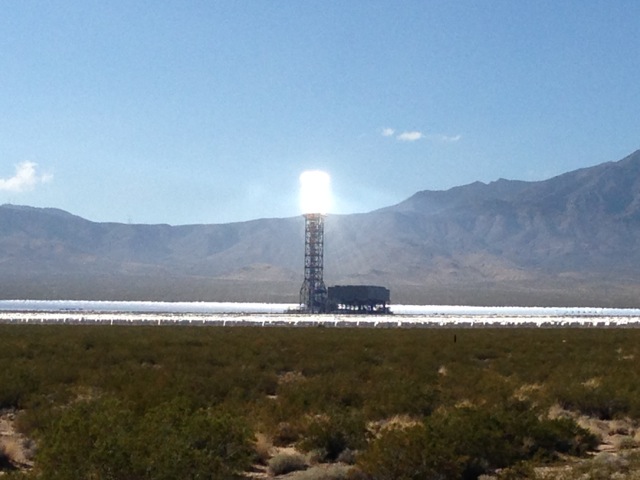
^Unit 1 of ISEGS in a test, perhaps at 80% or greater of mirrors aimed at the boiler on top of the tower to superheat steam.
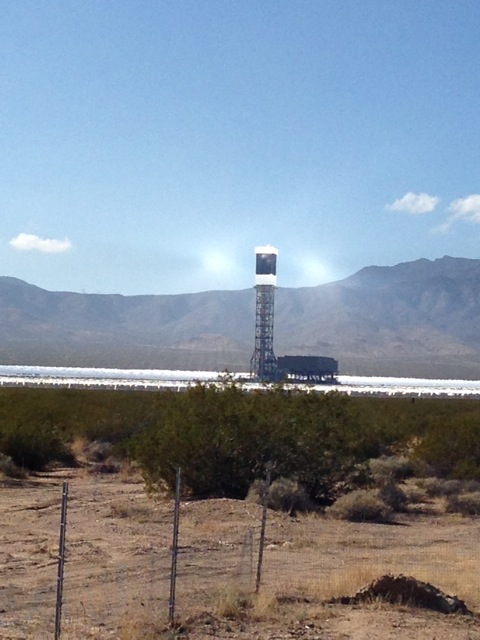
^Here the focus of the mirrors is aimed just off the tower, and solar flux can be seen as two light spots hanging in the air.
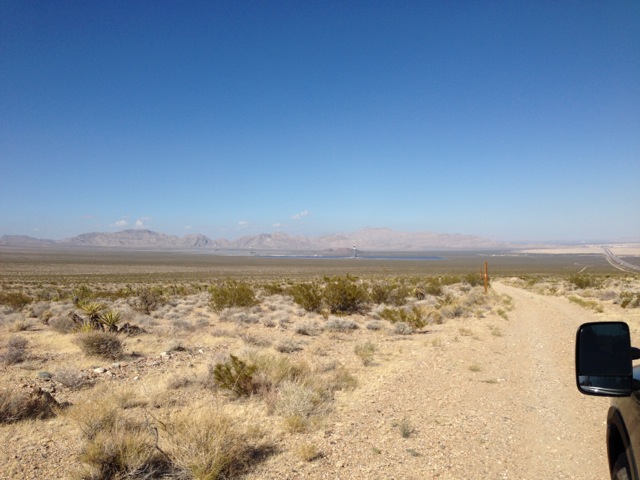
^The project in the distance looking northward. Interstate 15 lies to the right.
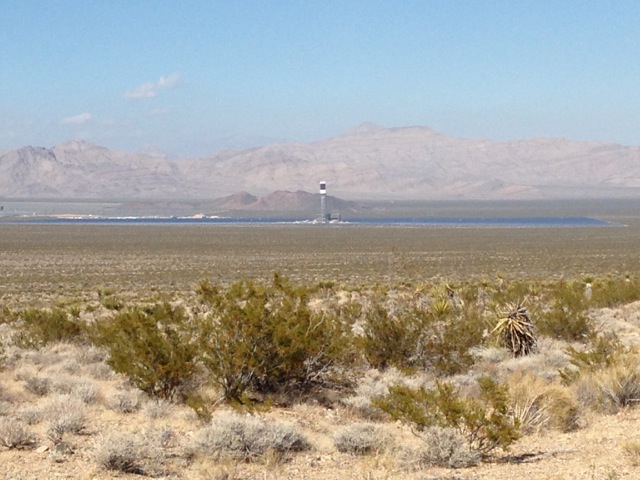
^Unit 1 as seen from near the Nipton Rd turnoff.
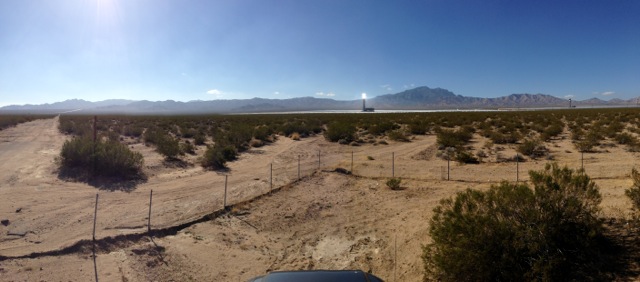
^The tower being tested. A tortoise exclusion fence is in the foreground. Clark Mountain in the Mojave National Preserve rises in the background.
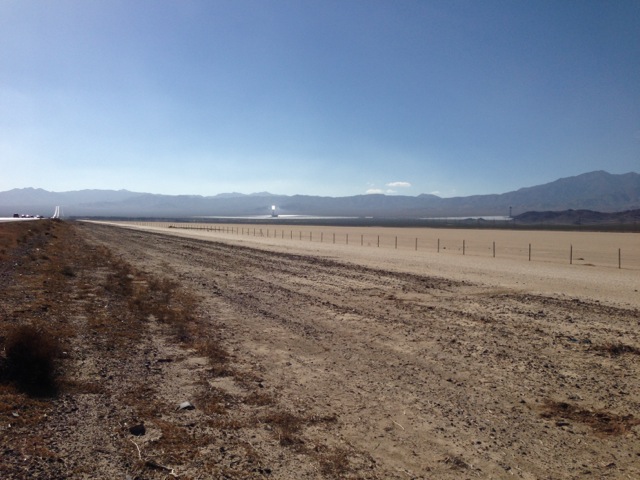
^Solar power tower testing as seen from Interstate 15 near Primm, NV.
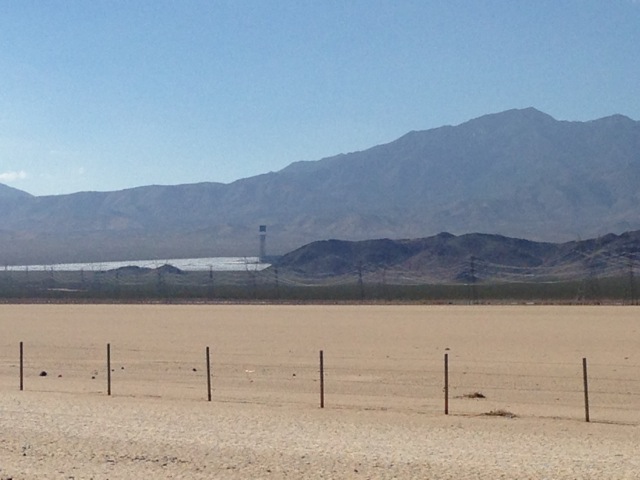
^Unit 2, off, under Clark Mountain.
Bird Mortality Reports
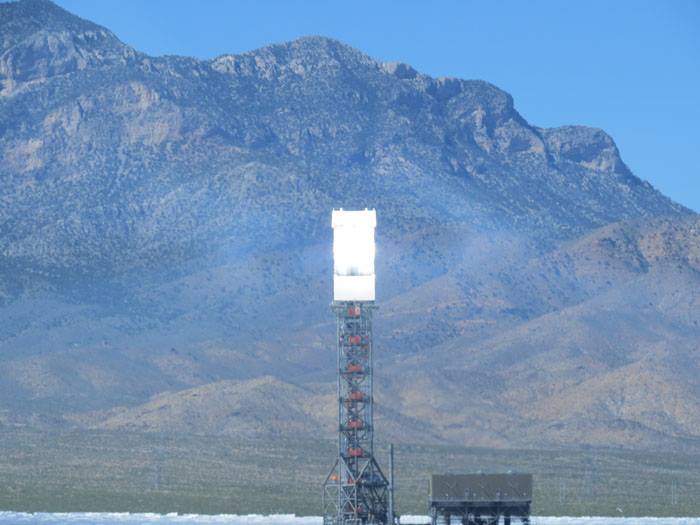
^Unit 1 being tested last week in Ivanpah Valley, showing the visible solar flux glow around the tower as mirrors aim bounced sunlight onto the target. The flux energy extends 2,000 feet out from the tower at decreasing strength.
October 1, 2013 - Numerous birds are being found dead or injured at the large-scale Ivanpah solar power tower project as it continues testing during the construction phase.
The California Energy Commission released compliance reports detailing the finds.
A Northern Rough-winged Swallow (Stelgidopteryx serripennis) was found injured on August 13, 2013 along Collosseum Road that goes through the project. The report says: "The swallow was found to be bright and alert, with normal posture but unable to fly. Eyes and beak appeared normal. There was marked curling, melting, and charring evident on the feathers of the wings, back, and tail. Substantial portions of the feather barbs were absent, apparently burned away. Both wings appeared equally affected, with the primary, secondary, and covert feathers showing the most evidence of damage. Covert feathers covering the back had evidence of minor curling and melting. Covert feathers covering the head, breast and ventrum were not obviously affected. The bird was able to fold its wings in a somewhat normal manner, and stand without difficulty. There was no evidence of ectoparasites, mechanical trauma, or chemical burns or residue. Damage to feathers was most consistent with thermal or electrical burns. The closest sources of extreme heat where the bird was found are the flood lights and generators located by the guard shack. There were also utility lines near its location. No flux has been produced in Unit 2 since May 14th and Unit 1 since July 17th. Flux in Unit 3 has occurred daily since August 5th and at various times during each day."
The description is more consistent with the damage a bird would suffer when it flies through the intense solar flux surrounding a power tower, and this bird may have flown through Unit 3 during testing, only landing some distance away. This had been predicted by experts during the CEC evidentiary hearing for the Hidden Hills solar power tower project.
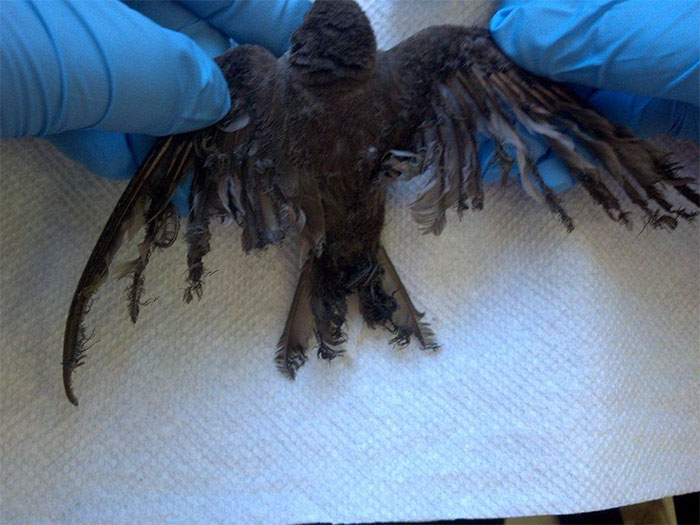
^Northern rough-winged swallow with feather burns.
Other birds found dead on the project site include such varied species as Greater Roadrunner (three different birds, one heliostat strike) and waterbirds such as Eared Grebe and American Coot (3, one from heliostat strike). Raptors found dead were a Cooper's Hawk and a Peregrine falcon (one juvenile with melted feathers on September 6, 2013). The other birds include many small songbirds which were either migrating through the desert or resident in the region: a Mourning dove (scorched, melted feathers), Yellow-Billed Cuckoo, Lesser Nighthawk (4, one heliostat strike), Common poorwill, White-Throated Swift (heliostat strike), Western wood-pewee, Ash-throated flycatcher, Blue-gray gnatcatcher (2, one with scorched, melted feathers), Common raven (electrocution), Yellow-Rumped Warbler, Wilson's warbler (2, one scorched, melted feathers and one tower strike), MacGillivray's warbler (scorched, melted feathers), Common yellowthroat, Black-throated gray warbler (scorched, melted feathers), Cassin's vireo (scorched, melted feathers), Loggerhead Shrike (4), Western Tanager (4, one heliostat strike), Horned Lark (heliostat strike), Northern mockingbird, Black-Throated Sparrow, Savannah Sparrow (heliostat strike), Chipping Sparrow (2, one with scorched, melted feathers), White-Crowned Sparrow, Black-throated sparrow (2, both heliostat strikes), Brewer's Sparrow, Green-Tailed Towhee, Lazuli bunting, Pine Siskin, House finch (scorched, melted feathers), and Brown-headed cowbird. Four unknown bird species were also picked up. The dates include November 27, 2011 through September 19, 2013.
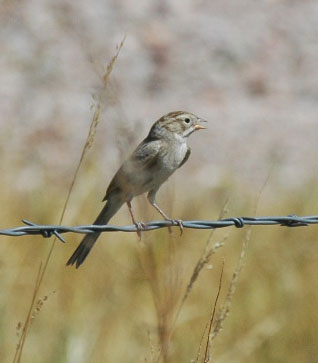
^Brewer's sparrow.
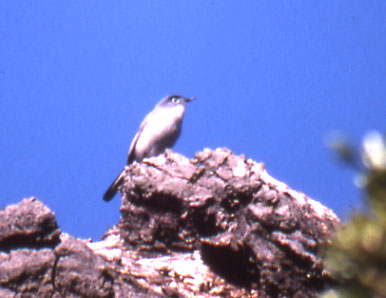
^Blue-gray gnatcatcher
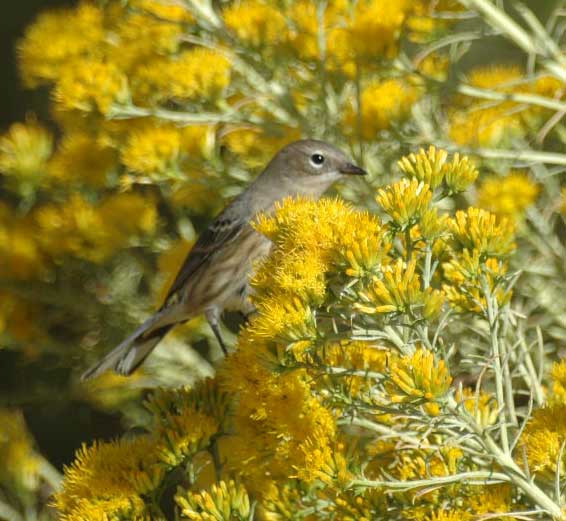
^Yellow-rumped warbler.
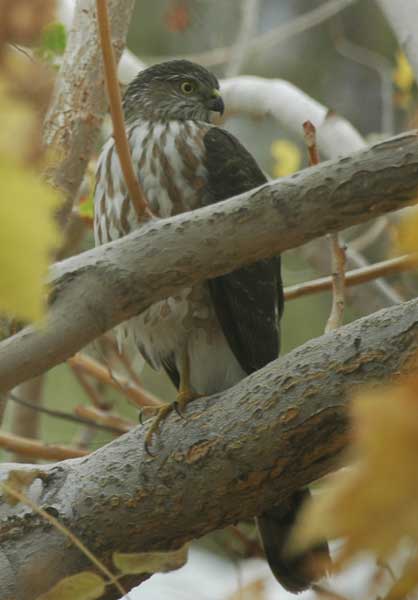
^Cooper's hawk.
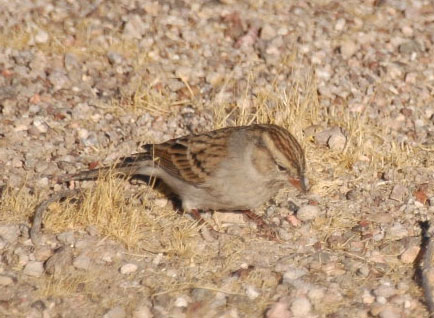
^Chipping sparrow.
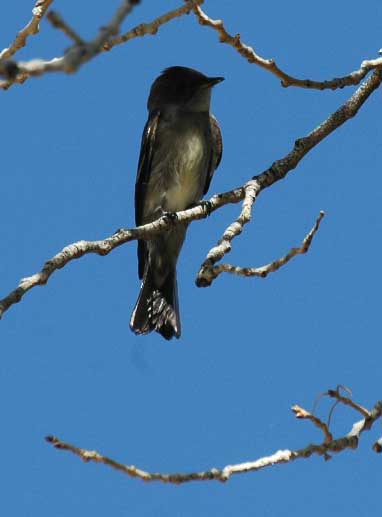
^Western wood-pewee.
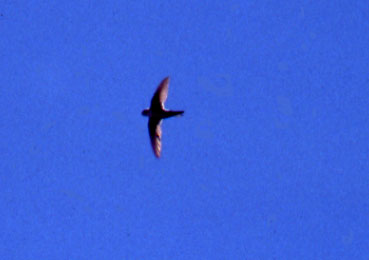
^White-throated swift.
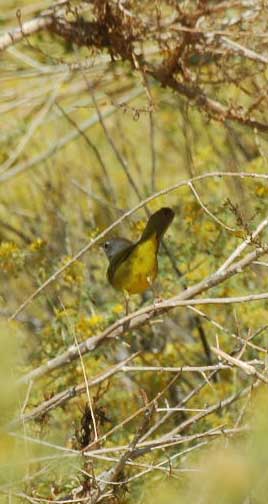
^MacGillivray's warbler.
HOME.....Ivanpah Solar Project.....Updates 1.....Updates 2
